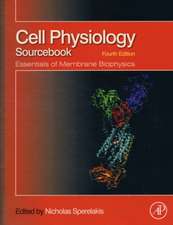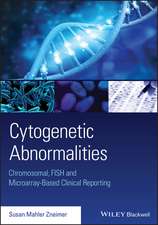DNA-Protein Interactions
Autor A. Traversen Limba Engleză Paperback – 30 apr 1993
Preț: 622.48 lei
Preț vechi: 732.33 lei
-15% Nou
Puncte Express: 934
Preț estimativ în valută:
119.13€ • 125.32$ • 99.40£
119.13€ • 125.32$ • 99.40£
Carte tipărită la comandă
Livrare economică 10-24 ianuarie 25
Preluare comenzi: 021 569.72.76
Specificații
ISBN-13: 9780412259906
ISBN-10: 0412259907
Pagini: 192
Ilustrații: 192 p. 3 illus.
Dimensiuni: 155 x 235 x 10 mm
Greutate: 0.28 kg
Ediția:Softcover reprint of the original 1st ed. 1993
Editura: SPRINGER NETHERLANDS
Colecția Springer
Locul publicării:Dordrecht, Netherlands
ISBN-10: 0412259907
Pagini: 192
Ilustrații: 192 p. 3 illus.
Dimensiuni: 155 x 235 x 10 mm
Greutate: 0.28 kg
Ediția:Softcover reprint of the original 1st ed. 1993
Editura: SPRINGER NETHERLANDS
Colecția Springer
Locul publicării:Dordrecht, Netherlands
Public țintă
ResearchCuprins
1 DNA structure.- 1.1 Structural features of DNA.- 1.2 DNA polymorphism.- 1.3 Conformational variability of DNA.- 1.4 Intrinsic bending of DNA.- 1.5 DNA supercoiling and topology.- 1.6 The topology of protein-bound DNA.- 1.7 Structure of supercoiled DNA.- References.- 2 DNA—protein interactions: The three-dimensional architecture of DNA—protein complexes.- 2.1 General principles.- 2.2 Local DNA conformation and protein binding.- 2.3 DNA wrapping.- 2.4 DNA configuration and sequence periodicity.- 2.5 The establishment of DNA architecture.- References.- 3 DNA—protein interactions: Sequence specific recognition.- 3.1 General principles of sequence specific recognition.- 3.2 Structural motifs for sequence specific binding.- 3.3 Co-operative binding to DNA.- 3.4 Co-operativity at a distance: DNA looping.- 3.5 Protein flexibility in DNA—protein complexes.- References.- 4 The mechanism of RNA chain initiation.- 4.1 The promoter.- 4.2 RNA polymerases.- 4.3 The kinetics of transcription initiation.- 4.4 The molecular interactions of RNA polymerase with a promoter site.- 4.5 The topological consequences of transcription.- 4.6 Transcriptional activators.- 4.7 Transcriptional activation by negative superhelicity.- 4.8 How does RNA polymerase melt promoter DNA?.- References.- 5 The regulation of promoter selectivity in eubacteria.- 5.1 Control of stable RNA synthesis.- 5.2 Stable RNA promoters.- 5.3 The transition from exponential growth to stationary phase and vice versa.- 5.4 Sigma factors and promoter recognition.- 5.5 The heat shock response.- 5.6 ?54: A target for transcriptional enhancers.- 5.7 The transcriptional programmes of bacterial viruses.- References.- 6 The mechanism of eukaryotic transcription.- 6.1 Eukaryotic transcriptional regulatory elements.- 6.2Eukaryotic transcriptional regulators: structure.- 6.3 Specificity and selectivity of eukaryotic transcription factors.- 6.4 Sp1 transcription factor.- 6.5 Heat shock transcription factor (HSF).- 6.6 How do transcriptional activators work?.- 6.7 Transcription by RNA polymerase III.- 6.8 The establishment of repression.- References.- 7 Chromatin and transcription.- 7.1 Local control of chromatin structure.- 7.2 The structural organization of chromatin.- 7.2.1 Chromosomal superstructure.- 7.3 Heterochromatin.- 7.4 The regulation of transcriptional competence.- References.
Recenzii
The value of this analysis is found in the insight it provides into the mechanism of complex systems.... the text is generally well-written and flows smoothly. [this work] is full of insights and stimulating in its unification of structure and function, a perspective that is increasingly inmportant in molecular biology. Trends in Genetics; Andrew Travers has done an excellent job of selecting examples illustrating the central theme of the book...the figures are instructive, well designed and selected...I wholeheartedly recommend this book for all structural and molecular biologists who are interested in the biological role of DNA - Trends in Biochemical Sciences; ...the book does bring together areas in a juxtaposition unique to its author...explained with the authority one would expect from Travers. - Nature; ...the book quickly takes us beyond the straightforward undergraduate texts, to provide a helpful source of information and discussion material for advanced undergraduate or Masters'courses. Journal of Biological Education; The value of this analysis is found in the insight it provides into the mechanism of complex systems.... the text is generally well-written and flows smoothly. [this work] is full of insights and stimulating in its unification of structure and function, a perspective that is increasingly r portant in molecular biology. Trends in Genetics; Overall, this is a densely detailed text and worth its place on the shelf of practitioners in the field who wish to maintain an overall view...gathers together current knowledge in a useful way - Current Biology








